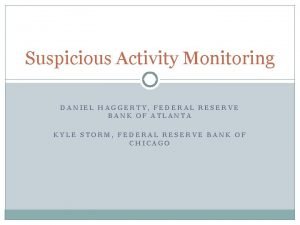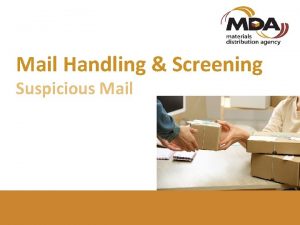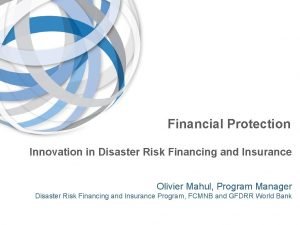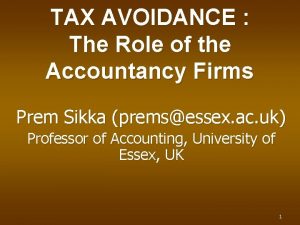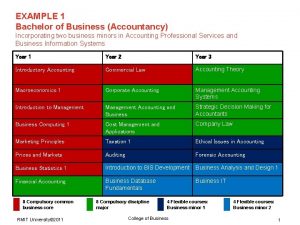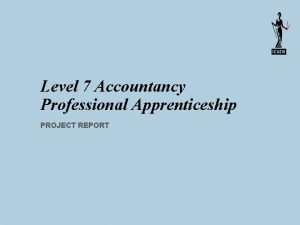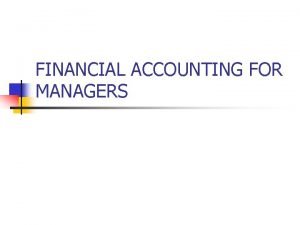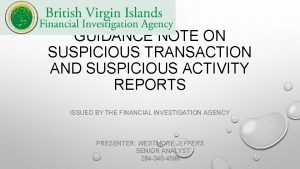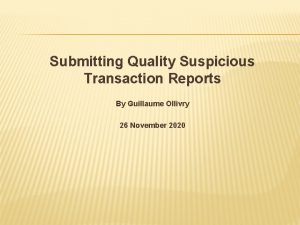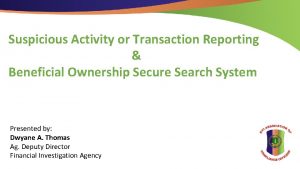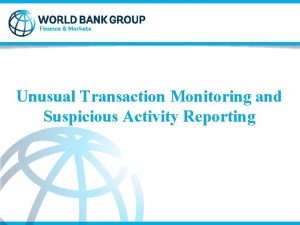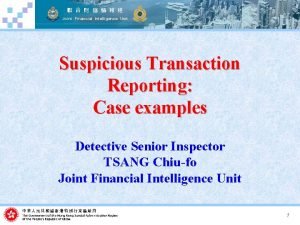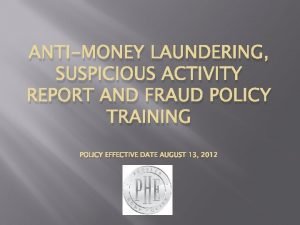Suspicious Activity Reporting for the Accountancy Sector SUBMITTING

Suspicious Activity Reporting for the Accountancy Sector SUBMITTING BETTER QUALITY SARS

The SAR Online reporting form How to construct a good quality SAR

The SAR Online reporting form Step 1 (SAR Header) SECTION INFORMATION TIPS Your Reference Include your own internal reference number here All fields marked with a red asterisk must be completed. SAR Type Select the type of report being made. This is where you should enter key information, including whether you are seeking a DAML Related Disclosure ID Make reference to any previous SAR to assist law enforcement Explain why the additional report is being made Include the 7 -digit NCA URN (not your internal reference number) Each SAR is considered on its own merits, so be sure to explain the reason for your further suspicion. Consent Required SAMPLE TEXT Tick the “Consent” box if a Defence Against Money Laundering (DAML) is being sought SAR Online has an automatic timeout of 20 minutes – always save your work! Save a copy of the SAR / DAML for your records before it is submitted.

The SAR Online reporting form Step 2 (Main Subject) SECTION INFORMATION TIPS Main Person For individuals, include full names, dates of birth, nationality, NI or other identification numbers, full addresses including postcodes, email addresses and telephone numbers All fields marked with a red asterisk must be completed. Main Legal Entity For entities, include full legal names, trading names and addresses, country of incorporation, registered addresses, details of beneficial ownership (if relevant to suspicion), Companies House reference numbers, email addresses This is where you should enter key information, including whether you are seeking a DAML SAMPLE TEXT SAR Online has an automatic timeout of 20 minutes – always save your work! Save a copy of the SAR / DAML for your records before it is submitted.

The SAR Online reporting form Step 3 (Associated Subject) SECTION INFORMATION TIPS Associated Subject For individuals, include full names, dates of birth, nationality, NI or other identification numbers, full addresses including postcodes, email addresses and telephone numbers Additional Associated Subjects can be included. SAMPLE TEXT Where there are multiple parties, restrict the Associated Subjects to those directly connected with the suspicious activity being reported For entities, include full legal names, trading names and addresses, country of incorporation, registered addresses, details of beneficial ownership (if relevant to suspicion), Companies House reference numbers, email addresses Reason for association State the relationship between the main subject and any Associated Subjects The Associated Subject is the former employee of the Main Subject SAR Online has an automatic timeout of 20 minutes – always save your work! Save a copy of the SAR / DAML for your records before it is submitted.

The SAR Online reporting form Step 4 (Transaction) SECTION INFORMATION Transaction • This Step may not be relevant to SARs submitted in the accountancy sector • This is not a mandatory section and can be skipped if not relevant • If there is available transaction information, include details here TIPS SAMPLE TEXT SAR Online has an automatic timeout of 20 minutes – always save your work! Save a copy of the SAR / DAML for your records before it is submitted.

The SAR Online reporting form Step 5 (Reason/Submit - 1) DETAIL KEY INFORMATION / QUESTIONS TO ASK YOURSELF SAMPLE TEXT Introduction • Always use applicable SAR Glossary Codes at the outset of this section – this allows the NCA to allocate and prioritise SARs appropriately, and identify trends. • Who are you? • What services were you providing when the suspicion arose? • Who are you providing these services to? • What is the nature of their business? • How has the suspicion arisen? • How has the suspicion come to your attention? • Who brought it to your attention? [GLOSSARY CODE] The following suspicion has arisen in the course of providing audit services / tax compliance services to Client Ltd is a manufacturer During the course of the audit, we were advised by management that… • Cross-refer to any previous SAR to assist law enforcement • Include the 7 -digit NCA Unique Reference Number (URN) – the number issued by the NCA on submission of the SAR • Do not use your internal reference number • Explain why the additional report is being submitted – each SAR is assessed on its own merits. The suspicion was originally reported on [date and NCA URN]. Further information has been obtained following a review of … Link to any previous SAR [GLOSSARY CODE] The following suspicion has arisen following the appointment of AB and CD as Joint Administrators in the insolvency of Liquid Ltd (Main Subject). The appointment was made at [High Court} on [date]. SAR Online has an automatic timeout of 20 minutes – always save your work! Save a copy of the SAR / DAML for your records before it is submitted.

The SAR Online reporting form Step 5 (Reason/Submit - 2) DETAIL KEY INFORMATION / QUESTIONS TO ASK YOURSELF SAMPLE TEXT Reason for Suspicion • Describe the nature of the professional services being provided by your firm. • Consider carefully whether you need to name your client. Are they relevant to the matter being reported? Note – the NCA may request this information, particularly if you are submitting a Defence Against Money Laundering (DAML). The following suspicion arose in the course of providing [e. g. statutory audit / personal tax compliance, financial due diligence / transactional advisory] services]. Identify key element of suspicion at the outset • The aim is to clearly state (a) the crime (b) the criminal property and (c) the money laundering • Think who, what, where, when, why? • Provide information chronologically • Avoid business language, acronyms or jargon. The report must be understandable without professional or specialist knowledge • Draft in Word / Notepad first to ensure not exceeding max 8000 characters • Provide clear, concise reasons for suspicion, relationship between the various subjects, the actual activity and criminal property involved, and the crime(s) suspected – bribery, tax evasion, fraud, etc. SAR Online has an automatic timeout of 20 minutes – always save your work! Save a copy of the SAR / DAML for your records before it is submitted.

The SAR Online reporting form Step 5 (Reason/Submit - 3) DETAIL KEY INFORMATION / QUESTIONS TO ASK YOURSELF SAMPLE TEXT Details of the criminal conduct • What is the nature of your suspicion? What criminal conduct have you identified (e. g. fraud / tax evasion / bribery)? What law has been broken (if known)? • Who are you suspicious of? Who is involved, and how are they involved? • Set out as much as you know about what they have done, in chronological order where possible. • Why is their conduct suspicious? • When did your suspicion first arise? Who brought it to your attention? How was it detected? • If the person has been dismissed or suspended, this should be stated. • Has there been an internal investigation? What was the outcome? • If known, state whether the suspicion has already been reported to relevant authorities (Police, Serious Fraud Office, HMRC, etc), or whether it is intended. Include any relevant crime reference numbers, where known. • Avoid business language, jargon, acronyms. In the course of audit of preparation for the y/e 2020 we met with the Finance Director of our client. In the course of discussions we were informed that during the year the company had been subject to a fraud by, now former, employees of the company. Following an internal investigation it was identified that R, J and F who were employed as managers were submitting claims for expenses for subcontractors named G, Z and B. It was claimed that G, Z and B were additional cleaning contractors brought in to assist with extra cleaning owing to Covid-19. We have been informed that it was apparent from an inspection that the cleaning had not taken place and the frequency and level of claims was out of step with claims being submitted by managers with similar responsibilities. The total expenses fraudulently claimed by R, J and F was £ 100, 000. It would appear that £ 50, 000 of this money was claimed by R (who has therefore been named as the main subject) and the balance equally split between J and F. As part of work we have not been provided with any further details of R, J or F, whose employment has been terminated. The fraudulent obtained sums have in part been recovered and we have been informed that the remaining sums will be repaid over the next 6 months. We do not know whether this matter has been reported to the police. We suspect R, J and F of being in possession of criminal property. SAR Online has an automatic timeout of 20 minutes – always save your work! Save a copy of the SAR / DAML for your records before it is submitted.

The SAR Online reporting form Step 5 (Reason/Submit - 4) DETAIL KEY INFORMATION / QUESTIONS TO ASK YOURSELF SAMPLE TEXT Details of the criminal proceeds / criminal property • What is the nature of the criminal proceeds/property? • How has the criminal conduct generated the criminal proceeds/property? • Describe the type and quantum (e. g. property worth £X, cash totalling £X, tax savings in the sum of £X) • State if quantum / value of the criminal property is unknown – it may be that you suspect criminal proceeds have been generated from the criminal conduct (e. g. fraud, bribery, tax evasion) even if their value is not known. • Estimates are useful but not obligatory. If included, clearly identify them as estimates. • Highest potential value estimates are helpful to the NCA – they assist with decision-making. • It may be that the known or suspected criminal conduct (e. g. tax evasion, or fraud) must have generated proceeds but their value is not known. The Main Subject is suspected of knowingly withholding VAT due to HMRC for its own benefit, namely the ongoing operation of its business. It is suspected that the Main Subject has committed the fraudulent evasion of VAT, an offence under the VAT Act 1994 • Where known, provide details of any other parties involved in the suspected ML activity, and their whereabouts • Where known, include any details of the whereabouts of any of the laundered property • Do you know, or have reasonable grounds to suspect, any other information that can help identify any other parties or the whereabouts of any of the laundered property, or any other information that may assist? It is suspected that the Main Subject’s Executive Assistant [full name ] may be in a position to provide more information regarding the circumstances of the fraudulent expense claims submitted by the Main Subject. The Executive Assistant raised the initial complaint regarding the Main Subject’s expense claims and resigned from their role at XY Limited on [date]. It understood that [name] is now employed by YX Limited in a similar role. Any other information that may assist This criminal activity may have resulted in estimated proceeds of crime of approximately £XX. SAR Online has an automatic timeout of 20 minutes – always save your work! Save a copy of the SAR / DAML for your records before it is submitted.

The SAR Online reporting form Step 5 (Reason/Submit - 5) DETAIL KEY INFORMATION / QUESTIONS TO ASK YOURSELF SAMPLE TEXT Final paragraph – link to POCA offences • Explain how the proceeds of crime may have been used, and how they give rise to offences under the Proceeds of Crime Act • It is not necessary to identify what specific POCA offence may have been committed As a result of this criminal activity, it is suspected the Main Subject may have used the proceeds of crime to fund the normal operation of its business (Concealing [Glossary Code] / Transferring [Glossary Code]), and may have committed money laundering offences under the Proceeds of Crime Act 2002 through the use / possession / acquisition/ disposal of the proceeds of crime. Defence Against Money Laundering (DAML) • Use the appropriate Glossary Code for DAMLs at the outset (XXS 99 XX, or XXGVTXX if the suspected money laundering valued at £ 3, 000 or less) • What is the basis for your knowledge or suspicion of money laundering? • Who is the person(s) or entity(ies) that you know or suspect are involved in money laundering (if known)? • What is the “prohibited act”? This must be a specific money laundering offence (under sections 327 -239 POCA only) that you would otherwise risk committing by continuing to deal with a matter and it must be a future specified activity. • What is the known/suspected criminal property? Include a description of the criminal property, its whereabouts, and its amount/value. • Provide a timetable of your proposed next steps in the matter / transaction. • Be aware of DAML notice and moratorium periods. • Ensure the ‘consent box’ is ticked in Step 1 of the SAR Online Form. XXS 99 XX Given our suspicion outlined above we consider that advising on the sale of Company X may lead to the shareholders acquiring criminal property and our involvement may amount to 'an arrangement' as prohibited under POCA 2002. Accordingly, we seek appropriate consent / a DAML to: [detail what you want / need to do e. g. – provide due diligence reports, structuring advice, setting up of companies, distributing assets to creditors, etc] SAR Online has an automatic timeout of 20 minutes – always save your work! Save a copy of the SAR / DAML for your records before it is submitted.

Resources Further information and guidance on SARs: • AML/CTF Guidance for the Accountancy Sector 2020 • ICAEW Suspicious Activity Reporting Help Sheet • Law Society of Scotland – Right First Time – Submitting High Quality DAML and SARs • NCA SARs Guidance page • HM Government Flag it Up Campaign • Financial Action Task Force (FATF) website for more information re potential indicators of ML and up to date information on high-risk jurisdictions

Appendix 1 Fundamentals How to construct a good quality SAR

Why are SARs important? • The National Crime Agency’s National Strategic Assessment of Serious and Organised Crime 2018 estimates the impact of money laundering at hundreds of billions of pounds annually. • Money laundering enables other serious crimes such as modern slavery, drug trafficking, fraud, bribery and corruption, and terrorism. • As members of the regulated sector, accountancy firms are under a legal obligation to report known or suspected money laundering, and failure to report may be a criminal offence for which you may be personally liable. • Accountants and professional services firms play a critical role, together with law enforcement and regulators, in combatting money laundering and other forms of serious and organised crime. • A good quality SAR can provide vital information to law enforcement, and help them to develop a clearer picture of suspected criminal activities or networks. • Criminal investigations can be based on multiple SARs – your report could provide an important missing piece of a wider puzzle.

Examples of red flags to look out for Activity Unusual or irregular activity that is inconsistent with your knowledge of the client’s business. Aborted transactions. Structures Complex or illogical business structures that obscure the person behind the engagement or transaction. Use of shell companies and offshore trusts Assets Client assets that inconsistent with what you know about their income Identity Is your client, or their beneficial owner, difficult to identify? Behaviour Is the client unusually anxious to complete the matter? Political Is the client associated with someone holding a prominent public function? Professional Is it unusual that the client has come to your firm for these services? Are they offering an unusually high fee? Geographical Is the client or the proposed work connected to a high risk jurisdiction? Industry Does your client operate in identified high risk sectors, such as gambling, crypto-currency, money transfer or payment services

Money laundering in the accountancy sector – what does it look like? Examples of potential money laundering activity in the accountancy sector: Business Line Criminal Activity Audit Identifying bribery or fraud at a client subsidiary Tax Suspecting a client has engaged in tax evasion Insolvency Distributing assets to creditors where you suspect the company has engaged in tax evasion or false accounting. Voluntary insolvency where there is a suspicion of fraud. Accounting Unexplained inconsistencies in accounts for which the financial controller is responsible Corporate Finance Providing due diligence advice where potential criminal activity is identified

Money laundering at a glance Criminal Conduct Criminal Property, Financial Benefit, Financial Advantage Proceeds of Crime Concealing, Disguising, Converting, Using, Acquiring, Becoming concerned in an arrangement Money Laundering

Types of Suspicious Activity Report (SAR) General SAR Defence Against Money Laundering (DAML) A SAR must be submitted where you know or have reasonable grounds to suspect money laundering. Further enquiries may be necessary to determine whether or not something is suspicious. However, there is no need to investigate or test your suspicion. Only make enquiries that would reasonably be expected within the normal scope of the engagement or relationship to avoid “tipping off”. Failure to report, tipping off and prejudicing an investigation are criminal offences. Reporters are protected under POCA from any potential client confidentiality breaches. However, do not include confidential information that is not directly relevant to the matter being reported. Previously known as a “Consent SAR” – the current NCA form still requires selection of “Consent” option where DAML required. SAR must be submitted where you suspect that the property you intend to deal with is criminal property, and the firm risks committing a money laundering offence (under s. 327 -329 POCA) if it continues to act as it intends. A DAML may be required in the following circumstances Acting on a corporate acquisition where suspected criminal property is being bought or sold by a client Providing outsourced business services to clients whose funds are suspected to have criminal origins Implementing trust or corporate structures where you suspect client is or will be using them to launder criminal proceeds Holding and distributing assets in insolvency work where there is a suspicion of criminal conduct Be aware of the notice and moratorium periods under the DAML regime.

Money Laundering offences in the regulated sector • Principal Money Laundering offences • Failing to report Concealing, disguising, converting transferring Failing to report knowledge or suspicion, or where there are reasonable grounds for knowledge or suspicion, that another person is engaged in money laundering (s. 327 POCA) Entering into / becoming concerned in an arrangement (s. 328 POCA) Acquisition, use or possession (s. 329 POCA) Money Laundering Offences • Tipping off Disclosing that a SAR or DAML has been made, or that a money laundering investigation is underway (or being contemplated), where that disclosure is likely to prejudice that investigation. • Prejudicing an investigation Knowing or suspecting a money laundering investigation is underway (or about to commence) and making a disclosure to anyone that is likely to prejudice that investigation.

icaew. com © ICAEW 2021
- Slides: 20
